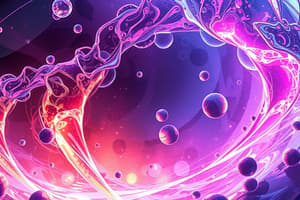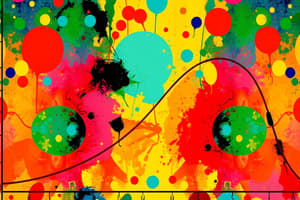Podcast
Questions and Answers
What happens to a substance's temperature when it undergoes a phase change?
What happens to a substance's temperature when it undergoes a phase change?
- It fluctuates irregularly.
- It continuously increases.
- It continuously decreases.
- It remains constant. (correct)
What is the main reason energy is supplied to a substance during a phase change?
What is the main reason energy is supplied to a substance during a phase change?
- To change the chemical composition of the substance.
- To increase the pressure within the substance.
- To overcome the forces between particles. (correct)
- To enhance the color of the substance.
When a gas is cooled, what occurs to the particles as they lose energy?
When a gas is cooled, what occurs to the particles as they lose energy?
- They come closer together and eventually form droplets. (correct)
- They vibrate wildly and lose their shape.
- They move faster and further apart.
- They stop moving completely.
What occurs to liquid particles if they are cooled further?
What occurs to liquid particles if they are cooled further?
Which of the following is NOT a phase change?
Which of the following is NOT a phase change?
What is the process called when a solid changes directly to a gas without becoming a liquid?
What is the process called when a solid changes directly to a gas without becoming a liquid?
Which of the following processes requires heat to be absorbed?
Which of the following processes requires heat to be absorbed?
During which process do particles gain energy and move further apart?
During which process do particles gain energy and move further apart?
What happens to the arrangement of particles during condensation?
What happens to the arrangement of particles during condensation?
Which interconversion occurs when a liquid becomes a gas at a temperature below its boiling point?
Which interconversion occurs when a liquid becomes a gas at a temperature below its boiling point?
What characterizes a saturated solution?
What characterizes a saturated solution?
What energy change occurs during freezing?
What energy change occurs during freezing?
What happens when the temperature of a saturated solution is decreased?
What happens when the temperature of a saturated solution is decreased?
What is the primary effect of heating a solid substance on its particles?
What is the primary effect of heating a solid substance on its particles?
Which statement best describes a supersaturated solution?
Which statement best describes a supersaturated solution?
Which of the following best describes the state of matter changes during sublimation?
Which of the following best describes the state of matter changes during sublimation?
Where on a solubility curve would you find an unsaturated solution?
Where on a solubility curve would you find an unsaturated solution?
Which factor typically increases solubility for solids in liquids?
Which factor typically increases solubility for solids in liquids?
What visual cue indicates a solution is saturated?
What visual cue indicates a solution is saturated?
How is solubility generally affected by temperature?
How is solubility generally affected by temperature?
What is the primary characteristic of an unsaturated solution?
What is the primary characteristic of an unsaturated solution?
What is the primary direction of diffusion?
What is the primary direction of diffusion?
What do the hydrogen chloride and ammonia gases produce when they meet during diffusion?
What do the hydrogen chloride and ammonia gases produce when they meet during diffusion?
Which of the following best describes the role of molar mass in the diffusion speed?
Which of the following best describes the role of molar mass in the diffusion speed?
What experiment illustrates the diffusion of colored solutions?
What experiment illustrates the diffusion of colored solutions?
What was observed when the crystal of potassium permanganate was added to water?
What was observed when the crystal of potassium permanganate was added to water?
What type of motion is involved in diffusion?
What type of motion is involved in diffusion?
What is the relationship between the mass of a particle and its speed of diffusion?
What is the relationship between the mass of a particle and its speed of diffusion?
What phenomenon is illustrated by the observation of Brownian motion?
What phenomenon is illustrated by the observation of Brownian motion?
What is the term used to describe the transformation of a solid directly into a gas?
What is the term used to describe the transformation of a solid directly into a gas?
In which state of matter do particles have a fixed position and make up an ordered arrangement?
In which state of matter do particles have a fixed position and make up an ordered arrangement?
During which change of state do particles gain a significant amount of energy, allowing them to move freely?
During which change of state do particles gain a significant amount of energy, allowing them to move freely?
What happens to the arrangement of particles when a liquid is frozen?
What happens to the arrangement of particles when a liquid is frozen?
Which process involves the conversion of a gas to a liquid?
Which process involves the conversion of a gas to a liquid?
In which state do particles move rapidly and randomly, resulting in high energy levels?
In which state do particles move rapidly and randomly, resulting in high energy levels?
What characterizes the movement of particles in a liquid state?
What characterizes the movement of particles in a liquid state?
What is the process called when a liquid transforms into a gas?
What is the process called when a liquid transforms into a gas?
During melting, what happens to the energy of the particles?
During melting, what happens to the energy of the particles?
Which alteration in arrangement occurs as water changes from liquid to solid?
Which alteration in arrangement occurs as water changes from liquid to solid?
What typically occurs to gas particles when they collide with the walls of their container?
What typically occurs to gas particles when they collide with the walls of their container?
Which of the following accurately describes the boiling point of a liquid?
Which of the following accurately describes the boiling point of a liquid?
What is the key characteristic of particles in a solid state?
What is the key characteristic of particles in a solid state?
What happens to the energy of particles during condensation of a gas?
What happens to the energy of particles during condensation of a gas?
Flashcards are hidden until you start studying
Study Notes
Types of Solutions
- Saturated Solutions: Contain the maximum solute that can dissolve; no more solute can be added.
- Unsaturated Solutions: Can still dissolve more solute; located below the solubility curve.
- Supersaturated Solutions: Unstable solutions with excess solute dissolved; typically have undissolved solute at the bottom; positioned above the solubility curve.
Solubility Curves
- The solubility curve visually represents how solubility of a substance varies with temperature.
- Temperature Effect: Solubility generally increases with increased temperature; decreasing temperature causes dissolved solids to crystallize as solubility decreases.
Particle Behavior in States of Matter
- Solid State: Particles are closely packed in an ordered arrangement (lattice); movement is limited to vibrations.
- Liquid State: Particles are in a random, irregular arrangement and can move past one another, maintaining close proximity.
- Gas State: Particles are far apart, move randomly and rapidly, and occupy available space, causing pressure.
Phase Changes and Interconversions
- Boiling & Evaporation: Transition from liquid to gas; achieved by adding heat to overcome intermolecular forces.
- Melting & Freezing: Transition between solid and liquid involving temperature change and energy absorption or release.
- Condensation & Sublimation: Change from gas to liquid or solid, respectively; energy exchange plays a crucial role in these transitions.
Energy of Particles in Different States
- Solid: Low energy, particles have fixed positions.
- Liquid: Moderate energy, allowing particles to flow past each other.
- Gas: High energy, leading to rapid and random motion.
Diffusion
- Definition: The process of particles moving from an area of high concentration to an area of low concentration.
- Influenced by particle size, temperature, and concentration gradient.
- Brownian Motion: Random movement of particles in a fluid, contributing to diffusion.
- Example: Potassium permanganate diffuses in water, showing gradual color spread due to constant movement of molecules.
Diffusion Experiment with Gases
- Reacting Gases: Ammonia (NH3) and hydrogen chloride (HCl) diffusing in a tube create a white smoke ring of ammonium chloride where they meet.
- Speed of diffusion correlates with molar mass; lighter gases diffuse faster, forming distinct patterns in diffusion experiments.
Studying That Suits You
Use AI to generate personalized quizzes and flashcards to suit your learning preferences.




